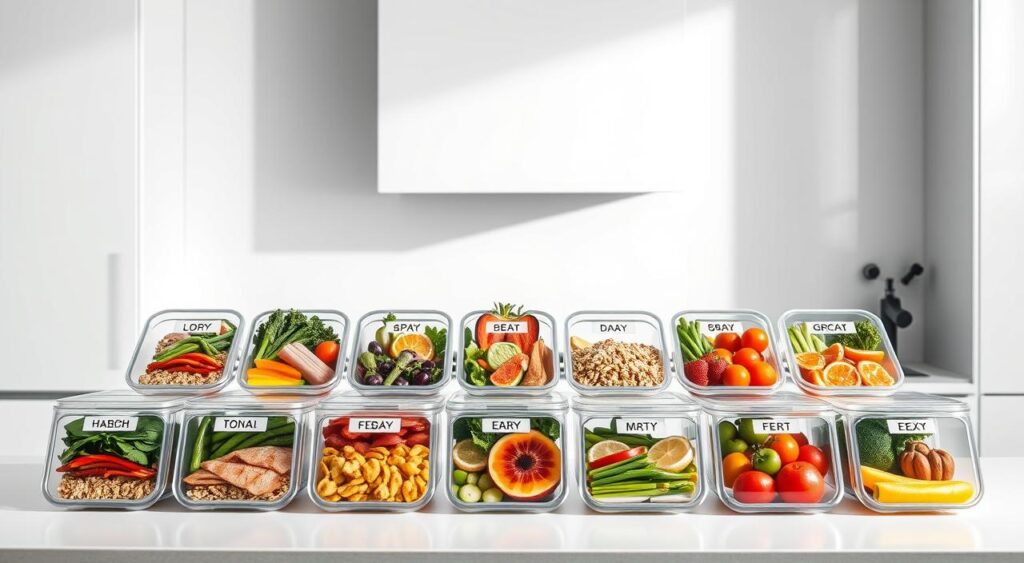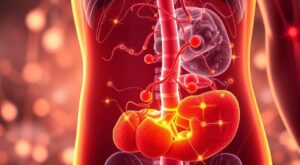Have you ever stood in front of the mirror, feeling frustrated with how your body is responding to all your efforts? You’re not alone. Many of us struggle with the challenge of weight loss, often wondering why it’s so hard to shed those extra pounds despite our best intentions.
The secret to transforming your journey lies not just in what you eat, but how you understand your own metabolism. This guide is here to empower you with a refreshing 7-day plan designed to boost metabolism and aid weight loss effectively. Together, we’ll explore actionable strategies to help you eat smarter and burn fat faster, so you can feel confident in your own skin.
Introduction to Metabolism and Weight Loss
Understanding how metabolism and weight loss are connected is key for those trying to lose weight. Metabolism is the process by which our body turns food into energy. A faster metabolism means you burn calories quicker, which is important for losing weight.
By knowing the role of metabolism, you can adjust your diet and workout routine. This helps your body burn more calories naturally.
A healthy metabolism not only helps with weight control but also boosts your energy. Activities that boost metabolism make losing weight easier and more lasting. Things like age, muscle mass, and how active you are can affect how well your body burns fat.
Understanding Metabolism: What You Need to Know
Metabolism is the process by which your body turns food into energy. It’s essential for your body to work well, whether you’re resting or active. The basal metabolic rate (BMR) is how many calories your body needs at rest. It changes based on your age, gender, and body type.
As you get older, your metabolism slows down, making it harder to keep weight off. Men usually have a higher BMR because they have more muscle. Muscle burns more calories than fat. Your genes and hormones also play a big role in your metabolism.
Knowing how to boost your metabolism is key. By understanding how diet, exercise, and lifestyle impact your rate, you can set goals for weight loss. Eating more protein or doing strength training can help increase your metabolism.
Why Is a Healthy Metabolism Important for Weight Loss?
A healthy metabolism is key for losing weight. It helps your body burn more calories all day. This means you can lose weight faster.
Metabolism also helps manage your energy. When it’s working well, you have steady energy. This makes it easier to stay active and do daily tasks. You won’t get tired easily, so you can work out longer and burn more calories.
Another important thing about metabolism is how it affects muscle mass. Keeping muscle is important for losing fat. Muscle needs more energy than fat, so a good metabolism helps you lose weight and keep muscle. This makes it easier to burn calories.
Without a healthy metabolism, losing weight is harder. A slow metabolism can make it tough to keep weight off. So, taking care of your metabolism is essential for lasting weight loss.
How to Boost Metabolism Naturally
Boosting your metabolism can really help with weight loss. To do this naturally, eat foods and do activities that speed up your metabolism. Eating enough protein is a good start. This is because your body uses more energy to digest protein, helping you burn more calories.
Adding high-intensity workouts to your routine is also smart. These workouts burn calories not just during but also after you exercise. Combining strength training with cardio is a great way to burn more calories.
Drinking plenty of water is key for a healthy metabolism. Even a little dehydration can slow it down. Try to drink water all day. Spicy foods, like peppers, have capsaicin, which boosts your metabolism. Adding these to your meals can make your metabolism work harder.
Here’s a quick look at some effective natural metabolism boosters:
| Food/Activity | Benefits |
|---|---|
| High-Protein Foods | Increase calorie expenditure during digestion |
| High-Intensity Workouts | Boosts metabolism post-exercise |
| Staying Hydrated | Maintains efficient metabolic processes |
| Spicy Foods | Enhances calorie burning through capsaicin |
Eating Smart: The Role of Intermittent Fasting
Intermittent fasting is becoming popular for improving metabolic health. The 16/8 method is a common choice. It means fasting for 16 hours and eating in an 8-hour window. This method makes meal planning easier and helps the body use fat during fasting.
What is the 16/8 Intermittent Fasting Method?
The 16/8 method splits your day into fasting and eating times. For example, you might eat from noon to 8 PM. This way, you skip breakfast but enjoy meals during your eating window. It doesn’t restrict food choices, allowing for flexibility. Following this method helps your body use energy better.
Benefits of Intermittent Fasting for Metabolism
Intermittent fasting has many benefits for your metabolism. It can improve fat burning and energy use. Here are some key advantages:
| Benefit | Description |
|---|---|
| Enhanced Fat Loss | Encourages the body to use fat as a primary energy source during fasting. |
| Simplified Meal Planning | Reduces the number of meals you need to prepare and think about. |
| Improved Insulin Sensitivity | May help lower blood sugar levels and improve insulin sensitivity. |
| Increased Growth Hormone Production | Fasting can stimulate the release of growth hormone, aiding in metabolism. |
For those interested in these benefits, a structured approach is helpful. Check out this intermittent fasting meal plan for guidance. As you start to see these effects, you’ll find that intermittent fasting changes how you view food. It also boosts your metabolism over time.
Metabolism and Weight Loss: Effective Strategies to Implement
Starting effective weight loss strategies can greatly improve your health journey. Activities that boost your metabolism lead to lasting changes. Here are simple steps to add to your daily routine:
- Mindful Eating: Listen to your body’s hunger and fullness signals. Eating slowly and enjoying your meals helps avoid overeating. This way, your body can better manage calorie intake.
- Regular Movement: Add physical activity to your daily life. It’s not just about the gym. Simple actions like walking, taking stairs, or stretching can increase your metabolism and aid in weight loss.
- Strength Training: Building muscle is a top way to boost your metabolic rate. Include strength-training exercises at least twice a week. This can lead to burning more calories even when you’re resting.
- Staying Hydrated: Drinking enough water is essential for a healthy metabolism. Aim for at least eight glasses a day, more if you’re active.
- Getting Adequate Sleep: Make sleep a key part of your weight loss plan. Lack of sleep can mess with hormones, making it harder to lose weight.

Using these strategies can improve your metabolism and weight loss. It also leads to a healthier lifestyle. Remember, consistency is important. Be patient and let your body adjust. Small, achievable changes can lead to big results over time.
Metabolism-Boosting Foods to Include in Your Diet
Adding metabolism-boosting foods to your diet can help you lose weight healthily. These foods are full of nutrients that boost your metabolism. This makes it easier to reach your weight loss goals. Here are some important food groups to include:
Fruits and Vegetables
Fruits and vegetables are full of vitamins, minerals, and antioxidants. They also have fiber, which helps with digestion and keeps you full.
- Leafy greens like spinach and kale are low in calories but high in nutrients.
- Berries, including blueberries and strawberries, are full of antioxidants and fiber.
- Citrus fruits like oranges and grapefruits boost your immune system and keep you hydrated.
Lean Proteins
Adding lean proteins to your meals can help with weight loss. Proteins take more energy to digest, which boosts your metabolism.
- Chicken breast is a low-fat protein source.
- Fish, like salmon and tuna, is rich in Omega-3 fatty acids.
- Legumes, such as lentils and chickpeas, offer plant-based protein and fiber.
Healthy Fats
Healthy fats are important for a good diet. They help improve your metabolism and support hormone balance.
- Avocados are full of healthy monounsaturated fats.
- Olive oil is good for your heart.
- Nut butters, like almond or peanut butter, are a good source of protein and healthy fats.
Crafting Your 7-Day Metabolism and Weight Loss Meal Plan
Creating a 7-day meal plan is key for weight loss. It helps you make smart food choices that boost your metabolism. A balanced plan controls calories and gives you the nutrients your body needs.
Sample Meal Plan Overview
This overview shows what a week of healthy eating looks like. It includes foods that help your metabolism and keep your energy up all day.
| Day | Breakfast | Lunch | Dinner | Snacks |
|---|---|---|---|---|
| Monday | Oatmeal with berries | Grilled chicken salad | Baked salmon with quinoa and broccoli | Almonds |
| Tuesday | Greek yogurt with honey and nuts | Turkey wrap with spinach | Stir-fried tofu with mixed vegetables | Carrot sticks |
| Wednesday | Scrambled eggs with avocado | Quinoa salad with black beans | Grilled shrimp with asparagus | Celery with peanut butter |
| Thursday | Protein smoothie | Lentil soup | Stuffed bell peppers | Fruit salad |
| Friday | Chia seed pudding | Chicken stir-fry | Baked tilapia with sweet potatoes | Greek yogurt |
| Saturday | Whole grain toast with peanut butter | Caprese salad | Vegetable curry | Trail mix |
| Sunday | Pancakes with maple syrup and berries | Salmon and avocado bowl | Chicken fajitas | Hummus with pita chips |
Day-by-Day Breakdown
Each day of the meal plan has balanced meals to boost your metabolism. You’ll eat lean proteins, whole grains, and lots of fruits and veggies. This makes it easy to stay on track with your diet while enjoying different foods all week.

Physical Activity: The Best Exercises to Accelerate Weight Loss
Getting active is key to losing weight. The best exercises work on different fitness areas and help burn more calories. A mix of strength training, cardio, and HIIT can really speed up weight loss.
Strength training is vital because it builds muscle. More muscle means you burn more calories even when you’re not moving. Try squats, deadlifts, and bench presses to build strength and burn more calories.
Cardio exercises like running, cycling, or swimming are great too. They raise your heart rate and improve endurance, helping you lose fat. Doing these regularly can really boost your weight loss.
If you’re busy, try HIIT. It involves short, intense workouts followed by brief breaks. This method burns a lot of calories in a short time. Research shows HIIT can lead to big fat loss and better health.
It doesn’t matter which exercise you pick, just stick with it. Mix up the best exercises for weight loss in your weekly plan. This way, you’ll not only lose weight faster but also stay healthy for the long term.
Metabolism Optimization: How to Maintain Your New Healthy Lifestyle
Keeping a healthy lifestyle is key for a good metabolism. As you get used to your new habits, it’s important to keep up with good eating and exercise. Eating whole foods, staying active, and taking care of yourself will keep your body in balance.
Here are some useful tips to keep your healthy habits strong:
- Plan your meals: Meal prepping helps you avoid bad choices and ensures you eat well.
- Stay hydrated: Drinking water boosts your metabolism and keeps you full.
- Engage in regular physical activity: Aim for 150 minutes of moderate exercise a week, mixing cardio and strength training.
- Monitor your progress: Keep a journal to track what you eat, exercise, and weight changes.
- Practice mindful eating: Eat slowly and enjoy your meals to feel full and satisfied.
By following these tips, you’re on the path to lasting weight loss. Every step you take helps improve your metabolism. Remember, patience and determination are your friends as you keep up a healthy lifestyle.

Common Mistakes to Avoid in Your Weight Loss Journey
Starting a weight loss journey is both thrilling and tough. Many people hit common pitfalls in weight loss that stop their progress. Knowing these issues helps keep you motivated and on track to your goals.
One big mistake is setting unrealistic goals. Losing weight takes time and hard work. Expecting quick results can make you feel frustrated. It’s better to aim for milestones that show healthy progress.
Another mistake is not eating enough. Some think cutting calories too low will help them lose weight fast. But this can actually slow down your metabolism and make it harder to lose weight. Eating a balanced diet is key to avoiding this mistake.
Ignoring exercise is another common error. Exercise is important for losing weight. It boosts your metabolism and helps build muscle. A good mix of exercise and healthy eating is the way to success.
To help you on your journey, here’s a table about weight loss mistakes and how to steer clear of them:
| Mistake | Consequences | How to Avoid |
|---|---|---|
| Unrealistic Expectations | Frustration and loss of motivation | Set achievable and measurable goals |
| Not Eating Enough | Slowed metabolism, fatigue | Focus on a balanced diet with adequate calories |
| Neglecting Physical Activity | Slower weight loss, possible muscle loss | Incorporate regular exercise into your routine |
By avoiding these mistakes, you can keep moving forward and enjoy a successful weight loss journey.
Top Metabolism Booster Supplements: Do They Work?
Many people wonder if metabolism booster supplements really help with weight loss. These supplements often include caffeine, green tea extract, and forskolin. They claim to boost your metabolism or burn fat, but the science is not always clear.
Studies show that some supplements can help a bit with weight management. But, the results are not as big as what ads promise. It’s key to remember that a healthy diet and exercise are also important for your metabolism.

Some turn to weight loss supplements hoping for quick results. Knowing what’s in the supplements and being skeptical of big claims is smart. While some supplements might help, a healthy lifestyle is much more effective.
Looking for a faster metabolism? Remember, supplements can help, but a healthy diet and exercise are more important. Use supplements to support your healthy habits, not replace them.
Long-Term Maintenance: Strategies for Sustained Weight Loss
Creating a long-term maintenance plan is key for lasting weight loss. It’s helpful to build consistent habits that support a healthy lifestyle. Learning more about nutrition and health can lead to better choices for your well-being.
Regular exercise is also important for keeping weight off. Aim for a mix of cardio and strength training. A goal of 2,000 to 3,000 calories of extra activity a week can boost your metabolism and help you stay at your target weight.
It’s also important to adjust your meal plans as your lifestyle changes. Being flexible with your diet helps you stay on track with your long-term goals. Having a supportive community, whether online or in person, can keep you motivated and accountable.
Tracking your progress is a big part of your long-term maintenance plan. Keeping a daily log of what you eat, exercise, and how you feel helps you reflect and make changes. This habit reinforces positive habits and helps you solve problems when they arise.
Lastly, don’t underestimate the power of social support. Being around people who value health can create a supportive environment. Joining group workouts or cooking classes can build friendships and keep you motivated to lose weight.
For more tips on managing weight long-term, explore behavioral strategies that lead to lasting results. A mix of personalized treatments and routines can help you stay committed to keeping weight off. For more information, check out this guide.
Conclusion
Reflecting on your journey through this 7-Day Metabolism and Weight Loss Plan is key. It shows the importance of a balanced approach to health. The right foods, a healthy metabolism, and exercise are essential for managing weight.
Understanding your metabolism helps with weight loss and improves your overall health. This knowledge is powerful.
Remember, the choices you make today affect your habits tomorrow. Try natural methods like intermittent fasting and eating foods that boost your metabolism. Regular exercise is also important for a healthier lifestyle.
These strategies can lead to lasting results. They help you achieve long-term changes.
By taking action and using what you’ve learned, you’re on the right path. Make these strategies a part of your daily life. Watch as your metabolism and weight loss goals come together for a healthier, more vibrant you.














